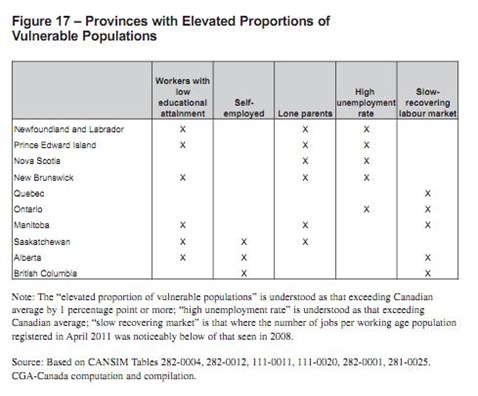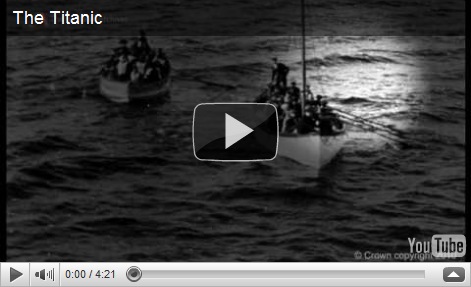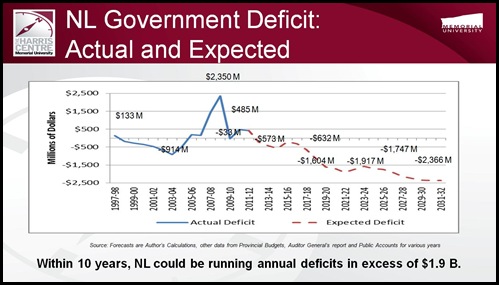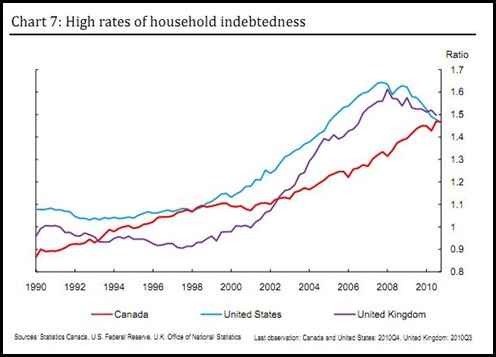Even to people not desperately in need of help in the wake of last year’s Hurricane Igor, it was pretty obvious - at the time - the provincial government was more geared to stoking and stroking political egos than anything else.
By the second or third day, media reports made it obvious that people desperately needed help, the provincial government couldn’t deliver help and that assistance from the federal government was a mere telephone call away.
Only a blind partisan or cockeyed optimist thought otherwise and - given the most recent developments - only a complete fool would claim otherwise today.
Information released to the Clarenville Packet under federal access to information laws documents the extent of the bungling inside the highest levels of the provincial government. we aren’t talking about the front line workers or contractors. We are talking senior bureaucrats, their political masters and their political masters’ legion of fart catchers.
An intra-agency meeting of the Regional Emergency Management Coordinating Committee (REMCC) was held the afternoon of Sept. 21. Representatives of Public Safety Canada, Environment and National Defense departments, and the provincial government noted resources were on standby.
Captain Michael Pretty of the Canadian Forces offered to have 180 staff deployed in six to 10 hours and the HMSC St. John’s and two helicopters mobilized.
The Canadian Coast Guard had 36 generators (125-700 watt) and 45 water removal pumps, with operators, available.
The province also had access to the national emergency stockpile of food.
The province declined all these offers.
And so it went day after day.
Evidence mounted that the provincial government simply was completely incapable of responding and at still the politicians refused to make a simple request for aid.
While the federal agencies standing by to assist initially thought the provincial government had a grip on things, by mid morning on September 23 they had changed their minds. The Packet quotes a federal situation report that power was out in wide areas, food supplies were running short and citizens were having to take matters into their own hands to deal with shortages of everything including medical supplies.
By the time provincial officials realised they were in the middle of a mess, they could not even draft a simple letter to request aid. The Canadian Forces liaison officer had to include a letter in an e-mail, asking the officials to print it off, sign it and send it back.
It still took the provincial government 24 hours more to respond and even then it very consciously and deliberately restricted the aid to the barest minimum. As the Packet reports:
The official RFA [request for assistance] was sent by the province to the federal Department of Public Safety at 2:07 p.m. on Friday, Sept. 24.
It asked, specifically, for “Sea King helicopters and the ship-based naval support necessary to maintain operation of said helicopters.
“For greater certainty, the province of Newfoundland and Labrador is requesting no other assistance from the DND at this time," the province stated in its request.
Thankfully, the federal officials ignored that last direction.
As Canadian Forces ships aircraft and personnel streamed into the province, the Prime Minister and Premier took a helicopter tour of a part of the region.
Danny Williams’ staff, meanwhile, had been co-ordinating a television appearance for the Premier all through the hurricane aftermath.
Williams left the Prime Minister later in the afternoon of Friday, September 24 and drove to a downtown St. John’s school where a crew from “This hour has 22 minutes” and a classroom full of elementary school students waited to record a sketch due to air the following week. The sketch featured Williams spewing some characteristic invective.
Just to illustrate the extent to which the provincial government’s bungling and miss-placed priorities were apparent at the time, take a look at posts your humble e-scribbler made last September. The first came on September 23. There’s another on September 24.
The second, a week later, highlighted the way in which the government’s public statements seemed designed to stroke political egos rather than provide concrete information to people affected by the disaster. It turned out to be an apt metaphor for what was going on inside the disaster response headquarters.
As the Packet notes, the first provincial assistance request to the federal government focused entirely on cash to pay compensation for victims. At a time when thousands were still stranded, lacking power and with dwindling food supplies, the provincial authorities were busily handing out claims packets and looking to Uncle Ottawa for cash. Meanwhile, the politicians were flying around staging photo ops for the evening news programs.
Danny Williams’ successor had a chance on Thursday to address the rather blindingly obvious shortcomings of the provincial government’s response. Kathy Dunderdale said everything had been handled very well. Not satisfied with the completely foolish response alone, Dunderdale went farther. The delay in asking for federal help was merely to ensure the provincial officials had proper plans. After all, said Dunderdale, all those soldiers, sailors and air crew would merely be an added burden on local communities already reeling from the disaster.
Yes, friends, in Kathy’s world, help is actually a hindrance. In the face of such comments, it doesn’t matter if Dunderdale is genuinely so stupid that she spouts such nonsense or merely thinks the rest of us are even more stupid such that we’d believe such a thing.
What matters is that her remarks are - without doubt or debate – utterly wrong.
They are stupid in a way that gives the word a new meaning.
The Canadian Forces came to Newfoundland last September with clothing, food, and shelter not only for themselves but for others as well. That is precisely why they came in the first place. They stood ready from the beginning to come from the moment the storm hit.
Had Danny Williams and his officials asked for them on the first day only to send them home shortly after, the whole affair would have cost them nothing. Under federal law, a provincial request for aid means that the federal government picks up the whole tab.
In other words, there was no legitimate reason for any delay in asking for help.
Yvonne Jones is right: Kathy Dunderdale owes the people of the Bonavista and Burin peninsulas an apology for the mess regardless of whether it was caused by political egos or old-fashioned incompetence. If Dunderdale had half a wit about her, she’d have acknowledged the problems and as the new Premier committed to right the wrongs.
Instead she told a monstrous whopper of a tale. You could call it a lie, but frankly, you cannot be sure that Dunderdale actually knows that what she said is drivel. Dunderdale might just be so inept that she must rely on briefing notes written by another incompetent.
And that is makes Dunderdale’s response all the worse. The public can loathe the showboat and all his puffing last September. He’s gone and no longer matters. She could have distanced herself from him safely and cleanly with no cost.
But Dunderdale didn’t.
She turnered up, yet again.
Last fall, your humble e-scribbler noted that natural catastrophes sometimes turn out to foreshadow political disasters. Well, no one could have foreseen the political disaster that is Premier Kathy Dunderdale.
Put Kathy Dunderdale’s demonstrated incompetence on Thursday over Hurricane Igor together with a series of events during her leadership (including her disastrous poll results in May) and you can bet she is going to get quite a surprise come the fall.
That is, Dunderdale will get a surprise in the fall unless a few of her more capable caucus mates decide to get rid of her before then for the good of the party and the province.
- srbp -








